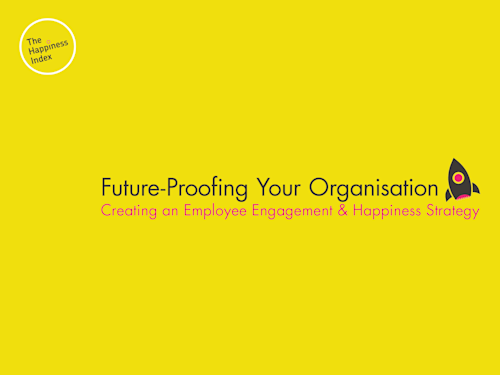
Creating an Employee Engagement AND Happiness Strategy
If your goal is to create a culture of listening within your organisation you’ve come to the right place! We love to help our customers embed feedback as a habit within their work lives. Read on to find our top tips for making listening an integral part of your culture and delivering an effective employee listening strategy.
When employees say they want their voices to be heard, they are really saying they want leaders who will not just hear them, but really listen to them.
Forbes
We all think we know our organisations, but it’s impossible for anyone to know exactly what everyone else is thinking or feeling. When you start an employee listening strategy, it’s best to put aside your feelings about what you think if or isn’t working within your organisation. Instead listen to what your people have to say.
If you bring prejudices or opinions into the process too early this can derail progress, and make your people feel they aren’t being listened to. This could cause problems with later surveys.
Although you need to get buy-in from everyone in your organisation, we recommend getting buy-in from leadership first. This way when you share the strategy and commitment with your wider team, they will understand that this is something that’s being taken seriously from the top. This will have a huge impact on embedding listening as a central tenet of your organisational culture.
Neuroscience shows us that clarity is a key theme when it comes to engagement. Information flow, and understanding requirements and organisational impact will help your team engage with your listening strategy more thoroughly, having clarity top-down will help with this.
To successfully reach as many people as possible in your organisation, creating clear comms, deadlines and signposting will be key. Think about whether you will use posters in communal areas, graphics on your intranet, company wide emails, or team meetings. We recommend a mix of these elements where possible.
You’re unlikely to get 100% response rates, but it is important to get a representative sample from all areas of your organisation. We have more tips about how to improve your response rate if you think you’ll need them.
To make the most out of your employee listening program, you need buy-in from your people. The best way to do this is to build trust by being transparent. This means clearly explaining the process, timelines and outputs from the outset.
Another key aspect to trust is anonymity. You will get both more and better data from this because your people will trust that their feedback will not be linked back to them. This will allow you to get a clearer and more accurate picture of where your organisation is.
The best thing you can do when starting your employee listening program is to make sure that gathering, analysing and most importantly giving feedback is as easy as possible. Ensure there’s an easy link to follow, information and deadlines are clearly signposted and surveys aren’t too long or complicated.
We believe that employee surveys should be available in appropriate languages on any device, but particularly should be accessible on mobile devices and desktop computers so people can give feedback when and where they like.
You don’t want someone opening the link and being faced with a wall of questions and text. Letting people know how long the survey is likely to take them, and how far through they are will help manage expectations.
We are often asked about benchmarking employee engagement and happiness. While we have access to thousands of data points across hundreds of companies in 92 countries, we don’t actually believe that benchmarking against all this data is the best way for organisations to achieve their goals.
Instead, we recommend benchmarking against yourself, as every culture is unique. Start your process with a survey that gives you a good idea of where your culture is and what the priorities are within your organisation. This will put you in a strong position to achieve your goals.
You may find the feedback is more candid than you expected particularly if you’ve included free text. Free text is very important in any employee listening strategy as it allows people to speak to you openly and freely using their own words. This gives you a much better chance to understand how your people are feeling and thinking as humans, rather than just as numbers on a scale.
Don’t become discouraged or take it personally. At this stage it’s key you all see the results as an opportunity to learn, grow and develop a people strategy that will support your entire organisation.
A key way to put your people in the centre of your employee listening program is to close the feedback loop. Try to reply directly to individual comments to ensure your people feel heard without breaking anonymity.
This gives more power to the employees allowing them to own the process, while still hearing directly from leadership. This is particularly important in larger or remote organisations where people tend to have less direct contact with leadership.
The next step is to share the results of your survey with the wider organisation, as well as action steps you will be taking off the back of the feedback. Ideally you will include timelines and measurable markers so that your people will be able to see that their feedback has been listened to and acted upon.
By committing to transparency and honesty you will build trust within your organisation. This will help you gain further insight in any follow up surveys or activity you run. You will also get a better response rate, meaning you can trust the data more.
We recommend that you are clear and honest about any areas you are unable to tackle, as well as blockers. The more transparent you are with your people, the more employee-centric your people strategy will be.
While we’re all about taking action at The Happiness Index, you need to be realistic about what you can achieve. Taking on more than you have resources - time and budget - for will only lead to disappointment for you and your team.
Instead we recommend focusing your attention. Ask the right questions for action planning before you dive in to make sure you’re setting off in the direction that’s most likely to lead to a culture that prioritises listening for your team.
You may not be able to utilise our closing the feedback loop all the time, or need to set clear expectations with your team as to when they will receive replies. You might not be able to use always-on listening, but prefer to have regular pulse surveys until listening becomes more part of your organisational culture. There are as many ways to approach listening as there are organisations.
If you’re really aiming to make listening a part of your cultural DNA, it needs to be part of everything you do. This is what we call a culture of listening.
Consider what works best for you as an organisation, for example pulse surveys vs always-on listening. There are less formal ways to ensure ongoing listening. Make sure as an HR professional you’re scheduling in 1-1 time with as many team members as you can whenever you can. Also, ensuring managers are properly trained in listening and giving feedback can seed listening at every level of the organisation.
Lastly, our always-on listening survey - Employee Voice - is a great way to give people the chance to give feedback and for you to listen to your team 24/7. Many of our incredible customers use this tool to ask for feedback on specific topics so they can get feedback on anything they’re doing!
Many organisations complete one-off surveys and call it a day. This is a mistake. Humans go through waves of emotion, and one-off surveys only provide a snapshot of how your people are feeling, thinking and behaving.
You may be able to commit to doing an annual culture survey. Or increase the frequency by utilising the different templates included in our library of surveys designed by our neuroscience experts to optimise your data and give you actionable data.
Monitoring your organisation’s sentiment on an ongoing basis means you can address concerns before they balloon into something much harder to fix. Organisations can create a culture of listening and focus on the most critical areas and put together timely and relevant action plans.

Linked to Happiness & Engagement in our neuroscience methodology... learn more
The Happiness Index helps organisations measure the key employee engagement AND happiness drivers to power their people strategy.
Our unique platform offers the products, insights and tools to shine a light on your cultural health and empower management to drive thriving cultures.
Our neuroscience-based pre-built surveys measure the full employee experience - from onboarding to exit to empower and enable organisations to understand their people and create data-led action plans.
